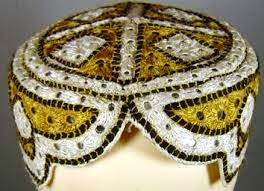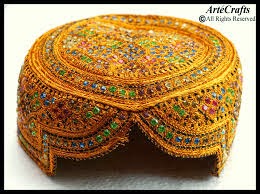The Sindhi cap or Sindhi topi (Sindhi: سنڌي ٽوپي ) is a hat worn predominantly by Sindhi people of Sindh province - however, it has been also adopted by the Baloch people and Saraiki people. Together with ajrak, Sindhi Topi is regarded as an essential part of Sindhi culture and a symbol of Sindhi nationalism for hundreds of years.[1]
The hat is circular/cylindrical except for a portion cut out in the front to expose the forehead. Intricate geometrical designs are embroidered on the hat, and very often small pieces of mirror are sewed into it also. In Sindhi culture, the Sindhi cap is often given as a gift or as a sign of respect, along with the ajrak. In December 2009, "Sindhi Cap Day" was celebrated in Pakistan's Sindh province to celebrate the Sindhi cap, and Sindhi culture in general. In 2010, the day was renamed to Sindhi Cultural Day. Hand-woven Sindhi Topis are work of hard labour. Sindhi Topi is primarily produced in Tharparkar, Umerkot, Sanghar, Kandhkot, Larkana, Nawabshah and some other districts of the Sindh.[2]
Sindhi Caps available in different colors and qualities. Choose the color from color list and quality level when you place your order.
The hat is circular/cylindrical except for a portion cut out in the front to expose the forehead. Intricate geometrical designs are embroidered on the hat, and very often small pieces of mirror are sewed into it also. In Sindhi culture, the Sindhi cap is often given as a gift or as a sign of respect, along with the ajrak. In December 2009, "Sindhi Cap Day" was celebrated in Pakistan's Sindh province to celebrate the Sindhi cap, and Sindhi culture in general. In 2010, the day was renamed to Sindhi Cultural Day. Hand-woven Sindhi Topis are work of hard labour. Sindhi Topi is primarily produced in Tharparkar, Umerkot, Sanghar, Kandhkot, Larkana, Nawabshah and some other districts of the Sindh.[2]
Sindhi Caps available in different colors and qualities. Choose the color from color list and quality level when you place your order.





